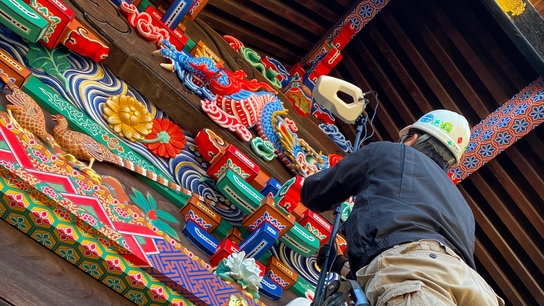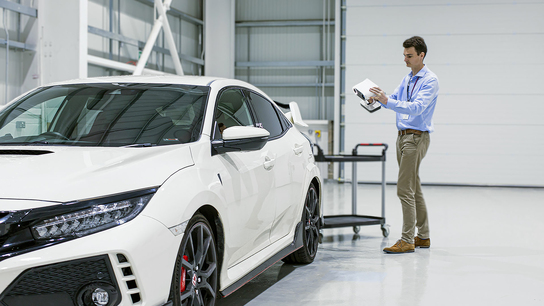Kurio 3D tailors compression leggings for Premier League stars with Artec 3D scanning
Challenge: Developing compression leggings that better fit the legs of athletes and patients in a way that helps fight fatigue and treat blood flow-related medical conditions.
Solution: Artec Eva, Artec Leo, Artec Studio, MATLAB
Result: An algorithm that directly converts 3D scans into tailored legging measurements. With their software and Artec Leo, the firm creates custom garments for some of the world’s leading footballers at a level of accuracy that’s simply impossible to achieve with traditional tape measuring.
Why Artec 3D? Graduating from Artec Eva to the fully wireless Artec Leo has allowed Kurio 3D to start effortlessly creating custom legwear for squads of players in less than an hour.

Nottingham Trent University’s Dr. Jack Ashby scanning a test subject with Artec Leo
If you’ve ever suffered from swollen limbs, encountered lower-body blood flow issues, or even just wandered around a pharmacy, you’ve likely already heard of compression leggings.
Designed to gently apply pressure to your legs and ankles, these snug-fitting, stretchy items of clothing work to prevent swelling, fatigue, and the progression of venous disorders. But as you can already buy them from shops all over the world, that’s problem solved, right?
Well, not necessarily, says Kurio 3D, a specialized sportswear developer that has customized compression leggings for over 4,000 athletes, including footballers in England’s Premier League and Championship, as well as players in several women’s national teams.

Ashby processing 3D scan data on Artec Studio
According to Kurio 3D, off-the-shelf products can only currently be fitted based on height and weight. Given that “there’s a lot of variation between anatomies,” the company says “this doesn’t tell you the size of someone’s legs,” and until it adopted 3D scanning, this had left a gap in the market for truly tailored athletic leggings.
“Some footballers are tall and really stocky. But you could get another player that’s the same height and built to run. The measurements of those legs will be completely different,” say the Kurio 3D team. “Then there are well-built footballers. Your average person won’t have a pair of calves like theirs! Because they have massive calves, they’ll have big quads and hamstrings as well.”
“Currently, you can’t buy tailored compression leggings off-the-shelf for athletes, it’s impossible, they don’t exist.”
Taking tailoring to another level
Born with a right calf smaller than his left, Kurio 3D’s director has first-hand experience of ill-fitting compression leggings. In his case, one legging would provide some compression, but the other would offer nothing at all. Having been taught to take tape measurements by his tailor father, he therefore set out to develop his own way of customizing leggings.
However, his early efforts proved laborious, and involved taking 34 leg measurements by hand. Seeking a means of automating this process, he later turned to Alex Chung, a Marketing Manager at Artec Ambassador Central Scanning. Chung helped identify a scanner with a usability and accuracy level that met Kurio 3D’s tailoring needs: Artec Eva.
At first, Eva served to streamline and digitize the firm’s measurement workflow. Light, compact, and easy to use, the time-tested 3D scanning solution can measure medium-sized objects like the human body at pace, and it has found extensive medical applications.
However, it soon became clear that greater flexibility would be required to optimize stocking fit. In pursuit of these goals, the Kurio 3D team experimented with extending their Eva’s cable and adding a 3.5-inch third-party display, to gain rudimentary real-time tracking capabilities.
Not long after this, Artec 3D changed the scanning landscape by launching a completely cable-free scanner: Artec Leo. Since upgrading to the rapid, AI-powered device, the Kurio 3D team has never looked back, becoming better able to deploy 3D scanning on-demand at remote sites, and capture athletes’ limbs from all angles.

Ashby using Artec Leo’s built-in display to ensure complete body capture in real time
“By lengthening the cable and attaching a display, I had basically tried to make myself a Leo, so I didn’t need to walk around with a laptop,” said the director of Kurio 3D. “But then Artec 3D brought Leo out, and it made my job much easier because it’s wireless and has a screen. It used to take about 15-20 minutes to manually measure a pair of legs, with me constantly on my knees and bending, now it’s just one and half minutes – that’s it.”
“We got in touch with Alex, and it came out of that, really. It was purely a case of finding the scanner that gave us the accuracy we needed – that was the most important thing for us.”
Kurio 3D’s “special sauce”
So, that’s how Kurio 3D ended up modernizing its measurement workflow. But the success of its business doesn’t rely entirely on cutting-edge hardware. Having found that Leo allowed athletes’ extremities to be captured with an accuracy of up to 0.1 mm, the firm still had to identify a way of turning resulting data into directly applicable measurements.
This is where close friend and Nottingham Trent University Lecturer Dr. Martin Lewis came into play. A mathematics whizz, programmer, and biomechanist all rolled into one, he’s said to have been central to developing an algorithm on programming platform MATLAB, that exports areas of scans as .csv files (spreadsheets) filled with measurements.
This algorithm, which Chung describes as Kurio 3D’s “special sauce,” works by converting scan cross-sections into something that can be read as a ‘cut and map code.’ Conveniently, the first step of this process can be carried out inside Artec Studio, using its cross-section hole-filling, and outlier removal tools, as well as its broad export format compatibility.
Once these meshes have gone through global registration, export, and processing via the company’s algorithm, they’re turned into a customized product, ready for manufacture.
Kurio 3D says the process delivers “much better accuracy and quality of pattern” than before, and from scan to finished product, it takes just 30 minutes to complete.
“It’s much faster than drawing the pattern. Our proprietary software actually identifies every one millimeter of circumference. We then take every tenth of a millimeter. Then that is laid onto a flat pattern,” adds Kurio 3D’s director. “In other words, it creates the pattern up the leg. It’s massive from our point of view.”
“We can scan a team of 25 in less than one hour. I can’t measure a team like that manually!”

A full leg scan captured with Artec Leo being processed on Artec Studio
As well as developing gear for top-tier footballers, the company has worked with a host of other sportspeople, ranging from cricketers to basketball players. But, having proven it can create compression leggings that outperform the off-the-shelf products of established brands, it isn’t stopping there.
Instead, the team says it’s continuing to “commit to 3D scanning” as “it’s the way forwards,” while looking into ways of optimizing full-body scanning, and uncovering opportunities there.
Moving into medical 3D scanning
To ensure its products are as beneficial as advertised, Kurio 3D has worked with academics such as Dr. Jack Ashby, a lecturer in exercise physiology at Nottingham Trent. Since carrying out initial performance validation testing of its stockings, Ashby has continued to work with Kurio 3D, while further exploring Artec 3D scanning’s clinical and sporting potential.
Specifically, using Nottingham Trent’s own Leo, he has begun looking into ways of treating illnesses like lymphedema. As one of the disease’s main symptoms is bodily swelling, it’s thought that tracking the rate at which this occurs with 3D scanning could help manage the disease, while bringing cost, safety, and speed benefits to hospitals.
“Existing imaging technologies are very expensive. If you want to perform MRIs every couple of weeks, cost becomes an issue,” explained Ashby. “Water displacement is also commonly used to measure leg volume. It’s fairly easy to do and cost-effective, but it takes about 20 minutes.”
“Trying to keep someone’s leg still without support is difficult and may increase measurement error. 3D scanning offers a non-invasive and efficient solution.”
Ashby’s research has revealed that 3D scanning is also more reliable than water displacement. When he compared upper and lower-leg 3D scanning measurements to those obtained via water displacement, he found that scanning offered better test-retest reliability.
As it turned out, measurements had a 3-5% chance of deviating (either by bias or error) from a leg’s true volume – consistently lower than the 4-7% seen in water displacement. While “this difference doesn’t sound large,” Ashby says it means that “if a leg’s volume changes by 5%, we can be more confident the 3D scanner would be able to detect this consistently.”
As a result, Ashby believes that “more research is needed in this area,” and this is something that he will continue to do, while healthcare organizations need to consider reliable technologies like 3D scanning for limb volume assessment.
“It brings us great joy to have been involved in the early stages of Kurio 3D as a research project with NTU back in 2017, all the way to full commercialization and the successes they are having now with Artec Leo and some high-profile clients,” added Chung. “We hope to continue being partners in innovation with Jack Ashby at NTU, as he seeks to use the technology in other pioneering areas of research.”
Scanners behind the story
Try out the world's leading handheld 3D scanners.





